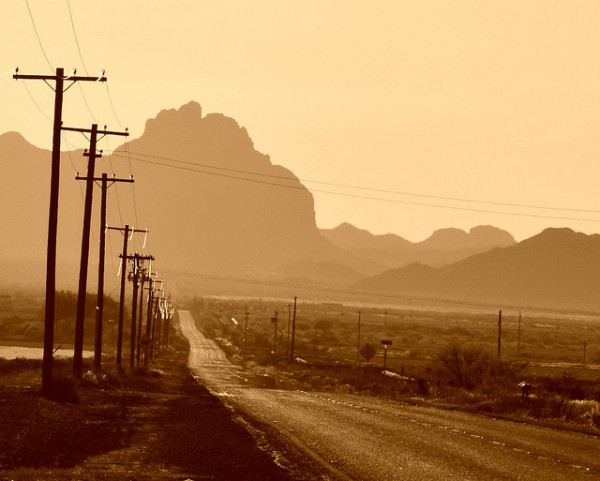
Phoenix has over a million inhabitants, and its metropolitan area has over four million inhabitants. That’s a lot of water, a lot of driving, and a lot of air conditioning. How long can a desert community of this sort, dependent on all sorts of imported resources, keep the party going? In advance of “Can Phoenix Become Remotely Green?”, a Zócalo event, several economists and environmentalists offer their thoughts on the potential greenness of Phoenix. Can Phoenix ever be made sustainable?
Sure, Phoenix can become sustainable–if it collapses and we start all over again

Can a city ever become sustainable? Ever is a long time. The question really is: Can cities like Phoenix become sustainable before they collapse? Can any of our cities become sustainable in time? Given the direction of the vast majority of our political and business leaders, the answer is easy to deduce: No, not a chance.
Phoenix has collapsed before. Sometime around the 14th or 15th centuries, when the Hohokam were the primary residents, a decades-long drought struck the region, and their civilization fell apart. When the rains and water levels returned, Phoenix rose up to become a small agricultural community. Then, in the mid-1950s, came the common use of air conditioning making the heat of the desert more bearable for more people. Later, in the 1990s, with the completion of the Central Arizona Project bringing water to the desert, the seeds of over-development and collapse were sown once again. After this coming collapse, who knows? Perhaps we will have learned something, and we’ll create a sustainable community where over-consuming Phoenix once existed.
In the meantime, could Phoenix, as it now exists, become sustainable? It would require a complete change in culture and a significant reduction in population. To be sustainable, a community has to live within the carrying capacity of the local environment. Phoenix and most major cities import just about everything to meet their needs, including food, water and energy. While Phoenix does have resources to meet all of its energy needs and more (except current modes of transportation), it does not have the local resources to meet its food or water needs for such a large population. Staving off collapse would require a population that uses far less water per person. It would also require local agriculture that uses very little water to grow vast amounts of food. This is not impossible. Will that happen? Given our misplaced priorities, what do you think?
John F. Neville is president of Sustainable Arizona.
————————————-
Sure–because any city is sustainable as long it’s sustained

Phoenix is not the least sustainable city. The least sustainable city is the next city whose population will go to zero.
The movement for “sustainable” cities has hijacked a good English word and redefined it to mean stagnant. Proponents of sustainable cities seem bent on creating terrariums for people. That is not what cities are about.
Here are some cities that have proven pretty sustainable, as measured by years of continuous habitation:
• Damascus, ~10,000 years
• Athens, ~6,000 years
• Delhi, ~5,500 years
• Thebes, ~5,000 years
• Rome, ~2700 years
• Sao Paolo, ~500 years
• New York, ~400 years
To be sustainable, a city must offer something that residents cannot get outside the city. Most cities have done so by being nexuses of commerce, convenience, and security. To be sustainable, a city must be vibrant and adaptable. The New York of 1650 might make a quaint diorama, but it isn’t a place where 10 million people could live–even if they cared to do so.
In their histories, cities have had to overcome an endless series of challenges involving water supply, sanitation, transportation, etc. While the solutions have often been very forward-thinking, they were not bound by a constraint that the solution only works if it will work forever.
Times change, challenges change, and solutions change. High energy use per capita is sustainable if the energy can be supplied. If a particular form of energy supply is not infinite, it will not be used infinitely. So what?
An ironic problem with the sustainability movement is that it threatens the attractiveness of cities by raising costs and imposing inconvenient lifestyle regulations. As it does so, it shifts development to the suburbs and beyond. That seems like an odd environmental goal.
Here’s what a city should do to be sustainable: Be an affordable and pleasant place to live and work. Plant trees along avenues–not because of the carbon dioxide they may consume, but because shade is nice in the summer. Don’t make people walk by imposing costs on driving. If you do, they will live and drive someplace else. Get people to walk by making walking convenient. Run good schools. Keep crime rates low. Let businesses flourish.
David W. Kreutzer is a research fellow in energy economics and climate change at The Heritage Foundation.
————————————-
Phoenix is getting more sustainable all the time

The city of Phoenix was leading the way in sustainability decades before “green” was cool. People may associate the color brown with our desert region, but “green” has saturated our policies for more than 30 years.
In the 1960s, Phoenix developed rubberized asphalt made from recycled tires; we adopted water conservation and energy-efficiency programs more than 30 years ago; our alternative-fuel program is now one of the largest programs in the country, with more than 50 percent of the city’s fleet running on alt fuel; and we were one of the first places in the nation to adopt a co-mingled, single stream residential recycling program. 20 years later, that recycling program remains a national model that other cities follow.
But that is our history. Today, we are focused on the future. The city has adopted an aggressive set of goals that we are well on the way to achieving. By 2025, 15 percent of the city will be powered by renewable energy. By 2015, we will reduce greenhouse gas emissions for city operations to five percent below 2005 levels. Our city will achieve 25-percent shade canopy coverage by 2030. And we continue to make great strides on our 17-point Green Phoenix Plan to become the most sustainable city in America.
This past year, Phoenix provided almost $1 million in incentives to homeowners and businesses to build “green” and adopted one of the first green construction codes in the nation. The city is rapidly installing solar power on city buildings–20 buildings so far. Today, Phoenix generates nearly one megawatt of renewable energy from solar. By 2012, that number will increase to 12 megawatts.
Our country’s largest desert city faces sustainability challenges not faced by other cities, but we see this as a challenge more than a liability. We are named for the mythical Phoenix bird, after all. We continue to rise to new challenges, and when it comes to sustainability, soar beyond anyone’s expectations.
Carolyn Bristo is sustainability officer for the city of Phoenix.
*Photo courtesy of Tony the Misfit.



